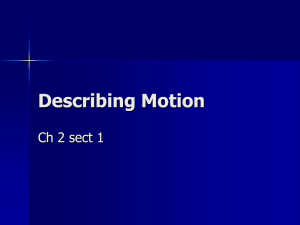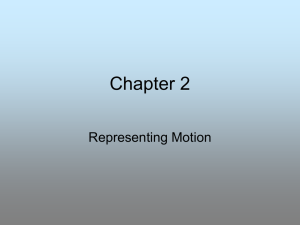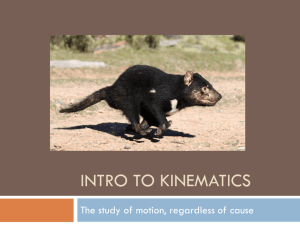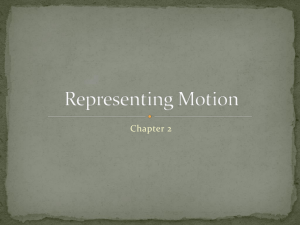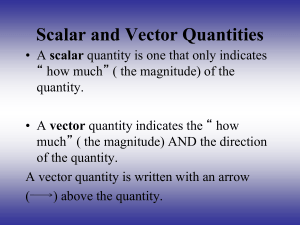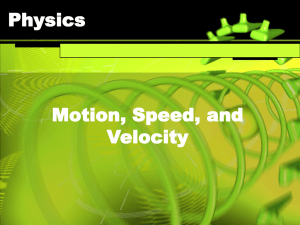What are the Essentials to describing motion?
advertisement
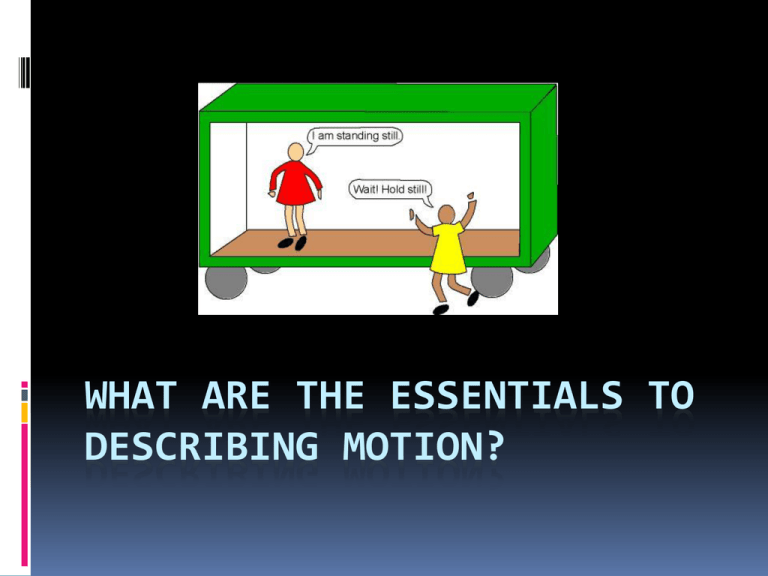
WHAT ARE THE ESSENTIALS TO DESCRIBING MOTION? How do you know whether something is moving or not? Using your tube “telescope” follow the object the teacher is holding. What happens to the telescope as you follow the object? Now carefully observe your teacher’s telescope. Was the ball “moving” during the two experiments? Explain. How can we describe motion? What is a Reference frame? A reference frame includes three essential components: 1. An object of reference, which is a real object in the physical world. 2. A clearly defined coordinate system. The coordinate system includes labels for the direction of the axis, such as north, south, east, west, left, right, up down, or positive and negative. The unit scale for measuring distances is also identified. A point on the coordinate system, usually the 0 point, is attached to the object of reference. 3. A clock which includes an origin t = 0 and a unit of measurement for specifying times and time intervals. Consider the following… • A blue car moves along a street with two passengers. One sits in the front passenger seat of the car and the other passenger sits in the back seat. • A red car moves in the same direction and is passing the blue car. • A green car moving faster than the blue car, is directly behind the blue car • There is a sidewalk along the road the cars are traveling and a pedestrian is standing on the sidewalk. Examine the map below. Your friend is visiting Washington DC and is staying at George Washington University. Your friend must walk across town to get to the Smithsonian Institution What are assumptions? Assumptions are issues we take for granted in an experiment. They can help us explain why the results weren’t exactly as we expected or could be something that wasn’t taken into account when we designed the experiment. Despite the outcome of the experiment, it’s important to consider the assumptions that may have been made. Assumptions are factors that could affect our results, but have not been included in our calculations or reasoning. What are some assumptions that may affect the time you tell your friend to leave? How can we define “motion”? Use what you have learned to define “motion”. Motion: An object is in motion with respect to another object (reference object) if, as time progresses, its position is changing relative to the reference object. Am I in motion? What is the scientific method? State the problem (question): How is the motion of the ball and the marks related? Form a hypothesis: If…then… Test your prediction: Experiment Analyze your data: Observe, make tables and graphs Draw Conclusions: Are there any relationships? What is a motion dot diagram? One representation of motion is called a dot diagram. To make a dot diagram mark locations of a moving object at equal time intervals. Describe the motion of objects A,B,C. Space and position In physics, the word position refers to the location of an object at one instant. A position is always specified relative to an origin. The net change in position relative to the origin is called displacement (takes into consideration direction). Position and distance Distance is related to, but different from, position. Distance is a measure of length of path taken without regard to direction. What distance did the man below travel? What is the final position (displacement) from the origin? What is a vector quantity? Scalar Quantity: Has magnitude (# or quantity) such as time, distance, speed Vector Quantity: Has magnitude and direction such as displacement and velocity. What is an index? An index is a number that helps people compare things. • Miles per gallon is an index of how well a car uses gas. • Batting average is an index of how well a baseball player hits. • Grades are an index of how well students perform on a test. How do we determine the “steepness” index? Rules for the Index 1. Each slide gets one steepness index because it has the same steepness all the way down. 2. You have to use the exact same procedure for each slide to find its index. 3. A big index value should mean that the slide is steep. A small index number should mean that the slide is less steep How do we make a graph of your results? Popping Index 18 Number Popped Kernels 16 14 12 10 8 6 4 2 0 0 2 4 6 8 Time (sec) 10 12 14 What is velocity? Velocity of an object moving at constant velocity is the slope of the position versus time graph Positive velocity means that the object is moving in the positive direction; negative velocity means it is moving in the negative direction. Speed is the magnitude of velocity, it is always positive. How do we express patterns mathematically? An object is moving in the positive direction at constant velocity v. It starts at clock reading t = 0 sec, at a position x0. How would you write a function that will allow you to find the position of the object at any time? Let’s start… Examine: Describe the relationship between the two variables. The object changes its position by 50 meters each second Define: Describe the variables used in the scenario t = time elapsed x = position Represent: Write a mathematical equation using the variables above (hint: how can you determine how far a car has gone in a given amount of time?) X = 50t Time (seconds) Position (meters) 1 50 2 100 3 150 Need Some Help? When mathematicians and physicists express patterns mathematically they use functions. A function is a rule that one uses to find a dependent variable when an independent variable is known. You may have met functions in a math class. There the independent variable was labeled x and the dependent variable is labeled y. Let’s Test Your Idea! Describe the relationship between the two variables. Describe the variables used in the scenario. Which variable is the dependent? Which variable is the independent? Write a mathematical equation using variables. How Many Velocities can an Object Have? ∆ ∆ ∆ What is the distance the football player traveled? What is the displacement? Expression for Displacement • Devise a method for obtaining the value for displacement and distance (path length) on a position versus clock reading graph. • Your friend says that to find displacement, he needs to take the position reading at point 2 and subtract the position reading at point 1. Do you agree or disagree? The displacement is written: ©2008 by W.H. Freeman and Company What is the Difference between Average Speed and Velocity? Speed: how far an object travels in a given time interval Velocity includes directional information: v x 2 x1 t 2 t1 x t ©2008 by W.H. Freeman and Company Now Draw a Velocity vs Time Graph Find the velocity at : 0-4 seconds 4-10 seconds 10-19 seconds 40/4= 10 yd/sec 0/6 = 0 yd/sec -45/9 = -5 yd/sec How do we find displacement with velocity vs time graph? Let’s go back to the Moving Man! Area under velocity curve = displacement

